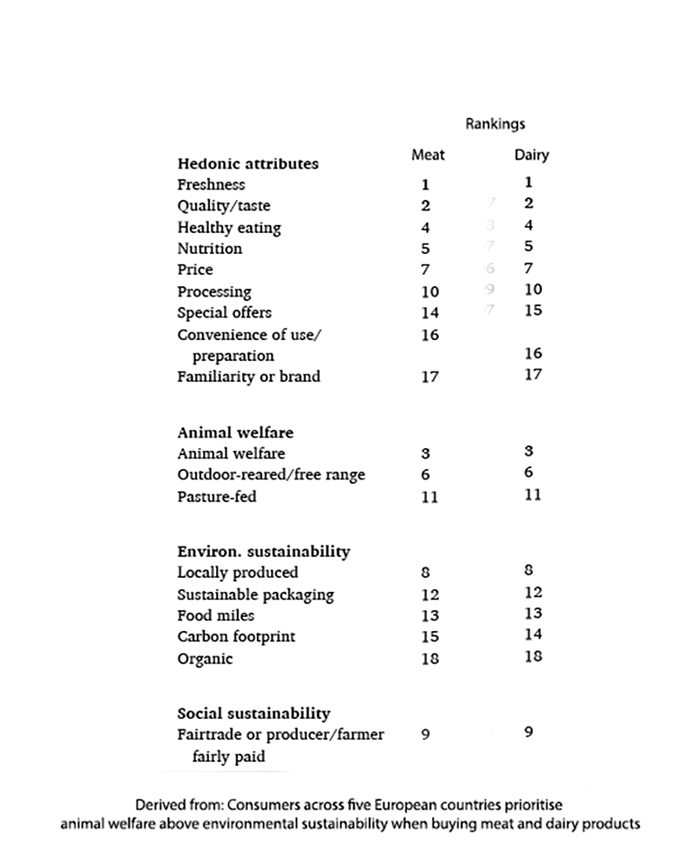A quarter or more of our environmental impact comes from our food production. Of course, the fact that we like to eat, and for many of us, that includes the great Satan of beef and dairy, makes it challenging to reconcile targeting food to reduce greenhouse gases and biodiversity losses. For some environmental activists, understanding why we purchase beef and dairy “facilitates transformation towards more sustainable consumption.” Identifying the drivers of our purchase decisions was the goal of a recent study reported in Food Quality and Preference. That information could then be used in labeling these products to nudge us toward sustainability.
“The perception of healthiness in relation to food choices, together with price, has been reported to be a more important determinant of food choices than environmental sustainability. A study in nine European countries found that price and taste tended to be more important than ethical concerns.” [emphasis added]
Could this really be true?
The research utilized an online survey involving 3,192 participants whose ages, genders, and educational levels represented five EU biogeographic zones. [1] They were asked to rate 18 different attributes when shopping for  meat and dairy products. These ranged from the hedonic, e.g., freshness, taste, nutrition, and price, to concerns over animal welfare, environmental sustainability, and social sustainability (justice).
meat and dairy products. These ranged from the hedonic, e.g., freshness, taste, nutrition, and price, to concerns over animal welfare, environmental sustainability, and social sustainability (justice).
Here are the aggregate rankings across all five regions. The pleasurable (hedonic), were ranked the highest. Animal welfare managed to make the award platform in third place. Environmental sustainability trailed at 8th,, organic origins came in last.
At least in this study, the pleasure and nutritional value of meat and dairy to the individual consumer was more important than the food source’s welfare, environmental impact, or organic origins. As the researchers point out, their findings “aligns with research that has indicated that taste and price are usually the main drivers of food consumption in general.”
“One information-based measure for communicating environmental sustainability information or animal welfare standards is product labels, which can be used or ignored by consumers and, as a consequence, are preferred by many consumers.”
The researchers noted that information regarding animal welfare was paramount in ranking the value of labels, followed by food safety and nutrition. As it turns out, labels have different meanings for different individuals. Who would have guessed? The research found that “personal attitudes were more important than socio-demographic characteristics” in reading labels making a one-size-fits-all approach less than productive.
The shift of priority for the concern over animal welfare from #3 in a buying decision to #1 in labeling reflects what in politics is described as the Bradley effect – “discrepancies between voter opinion polls and election outcomes.” What we want to see socially signaled can differ quite a bit from what we are willing to actually do. Moreover, labels fail to overcome personal attitudes. As a different study reports,
“Providing more information about animal welfare or the conditions under which animals are farmed alone is not enough to induce significant changes of consumers’ meat shopping behavior.”
Our response to labels is complex, entangling our beliefs, our need to signal or not to our peers, and what we are looking to purchase. This is seen in the low ranking of “organic.” The researchers try and explain why organic did so poorly, but their final thought on a study comparing sustainability vs. nutritional labeling is the most telling.
“This finding could indicate that consumers use the labels as heuristics without actually understanding the labels.”
There it is. For the most part, we don’t actually read the labels or understand the underlying information. Labels are just shorthand for good or bad, which is why there is so much regulatory fighting over what goes on in the front of the package. The environmentally conscious look for that information, the nutritionally concerned for those back of the package labels, but for most of us, it just comes down to taste and price.
“Labels alone are not enough to change behaviour, especially for consumers who have low or no behavioural intention to buy sustainable meat or dairy products.”
Ultimately, our love for tasty, affordable food remains a formidable barrier to environmental sustainability. Despite the best efforts to nudge us towards eco-friendly choices through labeling, most consumers prioritize taste and price over the planet. The dance between our beliefs, social signaling, and purchasing decisions means that simple labels are not enough to transform our behavior. If we aim for a sustainable future, the focus must shift from merely altering labels to fundamentally changing how we produce and perceive our food. Until then, the seductive allure of a juicy steak or creamy cheese will continue to trump our good intentions.
[1] The Czech Republic, a continental region; Spain a Mediterranean region; Sweden, a Boreal region; Switzerland, an Alpine region; and the UK, an Atlantic region.
Source: Consumers across five European countries prioritise animal welfare above environmental sustainability when buying meat and dairy products Food Quality and Preference DOI: 10.1016/j.foodqual.2024.105179




